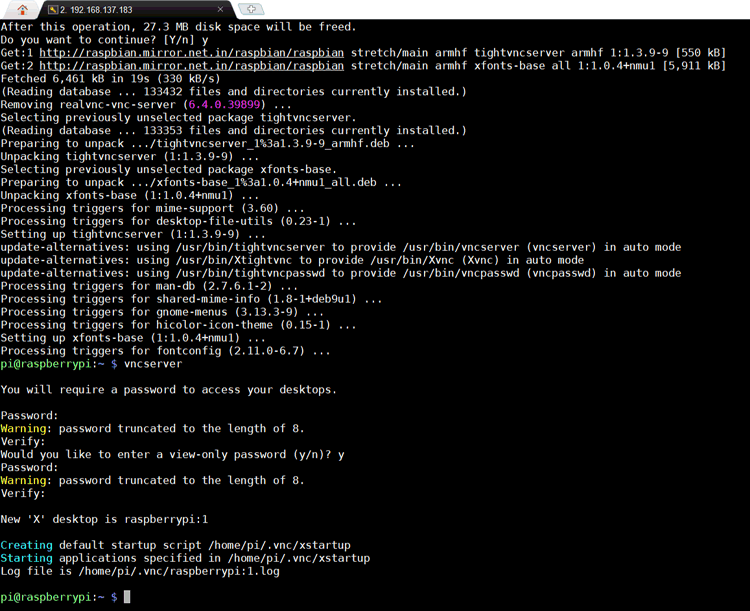
- TIGHTVNC SERVER CONFIGURATION 4 MONITORS HOW TO
- TIGHTVNC SERVER CONFIGURATION 4 MONITORS INSTALL
- TIGHTVNC SERVER CONFIGURATION 4 MONITORS SOFTWARE
- TIGHTVNC SERVER CONFIGURATION 4 MONITORS PASSWORD
- TIGHTVNC SERVER CONFIGURATION 4 MONITORS WINDOWS
# Use “-nohttpd” to prevent web-based VNC clients connecting. # Use “-nolisten tcp” to prevent X connections to your VNC server via TCP. # untrusted! For a secure way of using VNC, see

# DO NOT RUN THIS SERVICE if your local area network is
TIGHTVNC SERVER CONFIGURATION 4 MONITORS PASSWORD
# need to set a VNC password run ‘man vncpasswd’ to see how # as my ‘myusername’ (adjust this to your own). # Uncomment the lines below to start a VNC server on display :2

# The VNCSERVERS variable is a list of display:user pairs. I’m using vncviewer on local machine, and conf files on remote machine are The exams of 70-236 and 70-294 can be passed very easily. We offer guaranteed success in MB4-349 exams with help of latest MB6-205 and MB7-221.
TIGHTVNC SERVER CONFIGURATION 4 MONITORS WINDOWS
Because if you close vncviewer window and use vncviewer again, you will be given the desktop session where you left it (all windows open and applications running).
TIGHTVNC SERVER CONFIGURATION 4 MONITORS INSTALL
While I am forced to work on windows system, I install vncviewer and use it in full screen mode 😛 It also helps when you want to run some gui based application and monitor is remotely. Vnc is nice tool if you want to avoid using windows.
TIGHTVNC SERVER CONFIGURATION 4 MONITORS SOFTWARE
On windows there is a software called RealVnc. # vncviewer IP_Address:displayPort #(IP Address is for the machine where you set up saini]# vncviewer IP_Address:displayPort #(IP Address is for the machine where you set up vncserver) If service started successfully, you are ready to use vncviewer on a remote/local machine. To start vncserver, login as root and issue ‘service vncserver start’ command. This level can be set in server and proxy configuration files or using a runtime control option (-R loglevelincrease'http poller,N', where N is the process number). Enter password twice and you are done with password setting. Debug level 5 (trace) serves that purpose. Startkde & Step 4: Configuring passwordįor setting up vncviewer password for user ‘xyz’, login as user ‘xyz’ and issue ‘vncpasswd’ command on a terminal/konsole (or whatever). #xterm -geometry 80x24+10+10 -ls -title "$VNCDESKTOP Desktop" &

# Uncomment the following two lines for normal desktop: #xsetroot -solid grey #vncconfig -iconic & #xterm -geometry 80x24+10+10 -ls -title "$VNCDESKTOP Desktop" & #twm &

In the remote address, enter the BeagleBones IP address and add the :1 at the end and connect to the BeagleBone. There are many options to choose from, which will work. On the remote computer, a VNC viewer should be installed. I read that the server gives you setup options so I thought that would be where I should try to configure the monitor settings. Run the VNC server in order to allow the BeagleBone to start accepting remote connections with the tightvncserver :1 command. I tried ending the process and relaunching the server but it still does not come up. And the desktops disappear if the power goes away from the dual monitor machine, unlike running it on a VM in the UPS protected datacenter.#!/bin/sh # Uncomment the following two lines for normal desktop: #unset SESSION_MANAGER #exec /etc/X11/xinit/xinitrc & & exec /etc /vnc /xstartup When I click the server icon, it doesn't open any windows and then when I try to click it again it says an instance of WinVNC is running. It looks like Xmonad or Awesome might do this if I run it locally on the dual monitor machine, but I don't like the minimalism or tiling or the hotkeys - I prefer something like/similar to the default gnome environment (the default in Fedora 9 has been doing me just fine up to now).
TIGHTVNC SERVER CONFIGURATION 4 MONITORS HOW TO
I've spent ages searching for how to do this, and I've struggled even to find a window/display manager that will do this directly on the dual screen monitor setup, let alone thru a VNC session. I guess that this is like connecting multiple virtual monitors to a VNC session. When I'm at work, I have a dual monitor setup and want to be able to independently display any of the workspaces on either one of two VNC client sessions. When I'm at home, I will have a single VNC connection to this machine and want to be able to display any of the workspaces in the single VNC client session. I need to run the desktop on a VM running CentOS and be able to create VNC connections to the desktop. I'm after advice on how best to be able to work with sharing a set of desktop workspaces between two or more monitors.


 0 kommentar(er)
0 kommentar(er)
